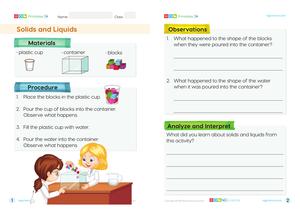Begin the lesson by introducing the concept of matter and its three states: solids, liquids, and gases. Highlight that today's focus will be on solids.
Go to the LessonLearning Objectives
- Identify examples of solid matter in the classroom.
- Describe the characteristics of solids, including having a definite shape.
- Explain that solids maintain their shape and size when moved.
Introduction and Hook
Engage students by asking them to identify solid objects around the classroom and discuss their characteristics.
Direct Instruction
Explain the characteristics of solids, emphasizing that they have a definite shape and size. Use examples like pencils and books.
Guided Exploration
Guide students through a discussion on how solids differ from liquids and gases. Use classroom objects as examples.
Hands-On Activity
Conduct a classification activity where students sort classroom objects into solid, liquid, and gas categories.
Independent Practice
Have students individually identify and list solid objects they find at home, describing their characteristics.
Check for Understanding
Review and Reflection
Conduct a class discussion to review what students have learned about solids and their properties.
Encourage students to reflect on how the knowledge of solids applies to everyday life.
Assessment and Extension
Administer the 'Solids and Liquids' assessment to test students' understanding of the differences between these states of matter.
Encourage students to explore further by watching the 'Lighthouse Lab – Matter' video, which provides a comprehensive overview of matter and its states.
Try the Quiz





